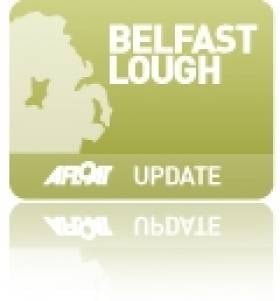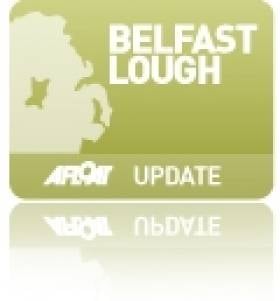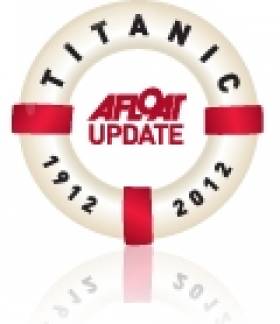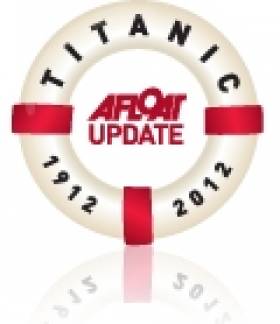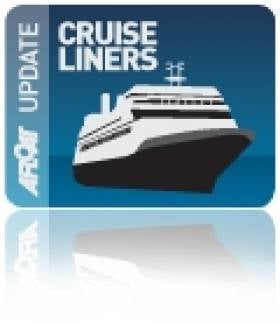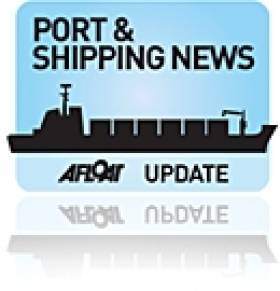Displaying items by tag: Belfast Port
170 Cruise Ships to Visit Belfast Port This Season
The number of cruise ships expected to dock in Belfast Harbour this season represents a 20% increase on the previous record set in 2019. In 2019, Cruise Belfast opened the first dedicated cruise terminal on the island of Ireland, and this purpose-built facility can accommodate all vessels currently operating in the UK and Ireland region.
The cruise industry in Northern Ireland continues to provide a welcome boost to the economy. Michael Robinson, Port Director for Belfast Harbour, said: “With 170 vessels due to dock in Belfast this year, it’s clear that cruise tourism is back on track in 2023. Last year, we had 141 calls to the Port as we transitioned from the 2021 cruise season, which was still partially curtailed by the pandemic, but this year we are on course to surpass our previous record year in 2019 as the global industry returns to full capacity.
"15 ships calling to Belfast for the first time"
He continued: “Cruise visitors make an important contribution to Northern Ireland’s tourism mix, attracting visitors from across the globe on day trips to attractions all across the region. We’re expecting a quarter of a million passengers to arrive at Belfast Harbour this season, which will provide an estimated £20m boost to the local economy.”
 Gary Hall of Belfast Harbour and Mary Jo McCanny, Visit Belfast, with Lea Goodsell, the two millionth cruise ship passenger to visit Belfast Photo: courtesy Planetradio
Gary Hall of Belfast Harbour and Mary Jo McCanny, Visit Belfast, with Lea Goodsell, the two millionth cruise ship passenger to visit Belfast Photo: courtesy Planetradio
This season will feature six embarkation cruises departing from Belfast with Ambassador Cruise Lines, where local residents can start and finish their cruise in Belfast.
There will also be 15 ships calling to Belfast for the first time, including Disney Dream, Norwegian Prima and MSC Preziosa, as well as Ambassador Ambition, demonstrating Northern Ireland’s increasing popularity as a cruise destination and providing a testament to the quality of award-winning visitor attractions across the region.
 The Belfast Harbour Cruise Ship facility
The Belfast Harbour Cruise Ship facility
Mary Jo McCanny, Director of Visitor Servicing at Visit Belfast, added: “This is an exciting year for the city as the tourism offering is going from strength to strength with more visitor experiences such as the Titanic Belfast multimillion pound refresh, the launch of Titanic Distilleries and McConnell’s Distilleries and the reopening of HMS Caroline. The quality of our visitor attractions throughout the region continues to draw visitors from across the world, and the Visitor Services team is excited to welcome them shore-side this season.”
Last month, Belfast welcomed its two millionth cruise ship visitor; according to Cruise Belfast, the partnership between Belfast Harbour and Visit Belfast markets the city as a leading cruise ship destination. The passenger who took the number of visitors to come to Northern Ireland on cruise ships past the two million mark was Lea Godsell on board the Norwegian Dawn.
Belfast Harbour Announce 5G Ecosystem for the Port
BT and Belfast Harbour today announced a landmark partnership to build a state-of-the-art 5G ecosystem within the Port. The partnership will deliver a series of 5G-led innovations to accelerate Belfast Harbour's digital transformation and help deliver its smart port strategic ambitions.
BT Group is the UK's leading telecommunications and network provider and a leading provider of global communications services and solutions, serving customers in 180 countries. Belfast Harbour is Northern Ireland's leading gateway for trade and tourism, handling over 70% of the region's seaborne imports and exports. It is also home to a vibrant community including commercial and residential real estate, film studios, ICT, R&D, heavy engineering and aerospace firms which employ 27,000 people.
In a UK and Ireland-first, BT will build and manage a live 5G Private Network designed specifically to achieve the highest levels of ultrafast mobile connectivity, coverage, reliability and security across the port's main operational areas. The highly secure and scalable network will enhance safety, security and sustainability across the Harbour Estate and is expected to go live across large parts of the 2,000-acre site early next year.
The strategic partnership follows a successful UK-first trial of 5G technology by BT and Belfast Harbour last year and supports Belfast Harbour's ambitions to become the world's best regional smart port.
Paul Murnaghan, Regional Director for BT's Enterprise division in Northern Ireland, said: "Our UK and Ireland-first 5G trial with Belfast Harbour last year was a powerful illustration of how 5G-led technology can transform the port's operations, propel the success of local businesses and drive economic growth. Today's deal with Belfast Harbour will make these benefits a reality, with the creation of a sophisticated digital ecosystem comprising of 5G as well as other emerging technologies such as AI, IoT and Connected Vehicles. This will act as a springboard for Belfast Harbour to achieve its ambition to be the world's best regional smart port and an innovation hub for the region. Ports are fundamental to the UK economy, and Belfast Harbour handles approximately two thirds of Northern Ireland's seaborne trade. With the rising demands on transport and logistics, and the growing need for operations to be safe, secure and sustainable, we're excited to work with Belfast Harbour as its technology partner, building 5G-led innovations to unlock the productivity benefits for the port and contribute to the region's green recovery ambitions."
Joe O'Neill, Chief Executive of Belfast Harbour added: "One of Belfast Harbour's key strategic ambitions is to become a smart port that engages creatively and effectively with customers, visitors and employees. Following a successful test programme last year, we are pleased to have engaged BT to bring 5G technology into Belfast Harbour and delighted that this private network is a first for the UK and Ireland. The smooth and efficient running of our Port logistics network relies on the accurate tracking and integration of data gathered from multiple sources. We believe the increased capabilities of 5G technology can have a beneficial effect on our operations, helping us for example to capture, process and interpret data in real time and giving insights that will speed decision making, better manage vehicle traffic through our Harbour Estate and improve productivity across our operations and services."
Belfast Harbour is an important gateway to trade and a significant contributor to the regional economy. Every year, more than 1.75 million people and over half a million freight vehicles arrive and depart through the Port, while 24 million tonnes of goods are managed and carried by ferries, container ships and general cargo vessels.
The partnership will examine how 5G and other emerging technologies such as AI, IoT and Connected Autonomous Vehicles can be used together to enhance public safety, physical security and address climate change across the Port and wider region.
The partnership will also explore how 5G capabilities can help Belfast Harbour maintain a safe and secure environment for businesses, employees and the wider public. For example, the two organisations will work on improved productivity and safety measures by enabling 5G remote controlled inspection technology to reduce the need for staff to work at height. Meanwhile, the roll out of 5G enabled sensors to monitor air quality and other environmental factors will support Belfast Harbour and the wider city in achieving its green recovery and sustainability ambitions.
Belfast Harbour ‘Bulked-Up’ by Record Tonnage Growth
#RecordTonnage - Belfast Harbour trade figures reveal that the port handled a record 23 million tonnes during 2014, up 46% since the recession's low point in 2009.
Overall tonnages rose by 1.6%, driven by strong growth in bulk cargo which accounts for over 40% of throughput at the Harbour. Trade sectors which grew particularly well included stone exports (18%), industrial and domestic coal (20%), paper products (33%) and steel (38%).
A record 476,000 freight vehicles also passed through the Harbour during 2014 (up over 2%), while container traffic improved by 2.9% to 125,000 units. The level of new car imports also rose by 10% to 48,000, its highest level since 2007.
Roy Adair, Belfast Harbour's CEO, said: "Surpassing 23 million tonnes for the first time is a major achievement for the Harbour, driven by our ongoing investment programme to deliver best-in-class facilities. It has also been supported by major investments from customers such as Stena Line which has introduced a third ship to its Belfast – Liverpool service.
"Improving economic and consumer confidence across the island has helped drive growth. Increased steel imports, for example, reflects greater manufacturing activity, especially in the Republic of Ireland, while the improvement in freight, containers and new car imports suggests a modest pick-up in consumer confidence.
"As the economy across the island has improved, so too has competition in the port sector. Belfast Harbour is actively pursuing a pipeline of new capital expenditure projects valued at £140m to support further economic growth across the Harbour Estate and to develop new and existing trade opportunities, ensuring that local businesses have access to world class facilities."
The Harbour's animal feed sector performed well, rising 3.3% to a record 2.2m tonnes, while scrap exports rose 14% to a record 373,000 tonnes.
Cement tonnages also improved, increasing fivefold to 79,000 tonnes. This was, however, from a small base and total cement tonnages remain less than one third of pre-recession levels.
Joe O'Neill, Belfast Harbour's Commercial Director said: "Exports from Belfast Harbour grew by 3.6% in 2014, accounting for 42% of all tonnages handled. In 20-years tonnages at Belfast Harbour have grown almost fourfold thanks to a rolling programme of Harbour investment totalling £400 m which has helped develop trade and attracted new business activity in the Harbour Estate.
"A major contributor to that success was Northern Ireland-based quarry firm, Conexpo, which grew its stone exports by 25% to almost one million tonnes in 2014 to meet demand from customers in GB and Europe.
"Conexpo is a good example of a SME whose export growth plans have been supported by Belfast Harbour's investments in new equipment and quays, and the availability of ever larger premises within the Harbour Estate. Our focus over the next 20-years is to ensure that the Harbour continues to grow and invest to support similar success stories."
Ferry passenger numbers remained steady during 2014 at 1.4m while cruise passengers calling at Belfast increased by 23% to a record 112,000.
NI Minister Greenlights Belfast Harbour Expansion
#BelfastHarbour - 4NI reports that Northern Ireland Environment Minister Mark Durkan has granted planning permission for a 60-acre extension to Belfast Harbour.
The expansion for port-related uses goes hand in hand with last year's announcement of Ireland's first dedicated cruise terminal for Belfast Harbour, that would accommodate next-generation cruise liners carrying more than 4,500 passengers and crew.
Minister Durkan said the expansion plans were "good news for Belfast" in terms of both enhancing the port and providing construction jobs.
Naming Ceremony Marks Second Tug for New Belfast Port Towage Operator
#NewTUGS - The tug Masterman was named at a ceremony in Belfast Port last week, the event marks the second tug for SMS Towage Ltd which launched a new towage service in early October, writes Jehan Ashmore.
The entry of SMS Towage to Belfast Port represents an investment in excess of £5m and is a response to the demand from port users.
The 50 bollard tonnes Masterman built in 2009 joins another omnidirectional tug Irishman completed in 1989 which has a bollard pull capacity of 40 tonnes. The pair are highly-manoeuvrable 24m tug boats capable of handling a full range of vessels.
They will be manned 24 hours a day and provide a 'just in time' service for the convenience of customers. The tugs first job was to assist the 43,000 gross tonnes bulk-carrier Billion Trader II.
SMS Towage's managing director Patrick Lyon said that the company had been set up to meet a clear demand for its services.
"We see Belfast as a strategic location. It is a vibrant port that will be home to a purpose built cruise terminal, a new offshore wind terminal and had a record year in 2012. We believe there is great potential for growth in the new business that will result in local employment."
The independent Northern Irish company will trade under the brand of SMS Towage, which operates on the River Humber and South Wales ports. Mr Lyon said that the company had grown quickly over the last 10 years to become the UK's largest independent harbour towage company.
Belfast Harbour Welcomes Return of Fred Olsen Cruise Lines
#BelfastCruises – This Autumn Fred Olsen Cruise Lines is 'bringing the world closer' to the people of Belfast, with three exciting cruise itineraries on board the 880-guest Boudicca.
According to Breaking Travel News, guests will have the opportunity, for the first time since 2007, to embark on a Fred. Olsen cruise from Belfast, without having to endure an expensive flight or long ferry crossing to reach its ships.
Boudicca will be offering a 10-night D1322 'Scandinavian Cities Cruise', departing on 23rd September 2013, a 12-night D1323 'Portugal, Madeira & the Canaries' cruise, departing on 3rd October 2013, and a two-night mini-cruise, D1324 'Liverpool Highlights', departing on 15th October 2013.
As previously reported, Braemar, a fleetmate of Boudicca had called to Dublin and Liverpool over the weekend.
Titanic Memorial Cruise Heads for Cobh
#TITANIC MEMORIAL CRUISE - Following Balmoral's recent call to Belfast in memory of Titanic, the Fred.Olsen Lines cruiseship returned to Southampton where today she started a 12-night Titanic Memorial Cruise which will follow the White Star Line liner's original itinerary that included calling to Queenstown, now Cobh.
Before Balmoral calls to Cobh tomorrow, she is to pass Cherbourg, where the passenger tender SS Nomadic served the liner that layed anchored offshore. The 101 year-old tender was also built by Harlalnd & Wolff and she is undergoing restoration work in Belfast, to read more about her click HERE.
Likewise to Balmoral's Belfast visit, her arrival to Cobh is the inaugural call for this year's season, though her poignant arrival will be two days short of Titanic's call a century ago on 11th April 1912.
On Titanic's second anchorage at Queenstown, this too required tenders to transfer 123 passengers who embarked from the town's pier and of those only 44 survived the disaster. The timber built pier still exists albeit what survives is in a derelict state. There have been calls to raise funds to save the structure as previously reported.
Along the scenic waterfront passengers can take a tour of the town's new Titanic Experience in the White Star Line building, the Queenstown Heritage Story in the Cobh Hertiage Centre and the walking Titanic Trails.
From Cobh the Balmoral will sail across the Atlantic, arriving at the Titanic site on April 14th/15th - exactly 100 years on from this tragic voyage, where a memorial service will be held to pay tribute to the brave passengers and crew who perished on that fateful night.
The cruise will then continue to Halifax, Nova Scotia, the final resting place of many who were on board, before sailing on to New York, the Titanic's ultimate planned destination.
- White Star Line
- RMS Titanic
- Balmoral
- Fred Olsen Cruise Lines
- Titanic Memorial Cruise
- Cobh Cruise Calls 2012
- Belfast Port
- SS Nomadic
- Titanic's passenger tender
- Cruise ship news
- Cruiseships
- port of Cork
- Cobh Cruise Terminal
- Titanic Trails
- Cobh Heritage Centre
- White Star Line liners
- Queenstown,Ireland
- Harland & Wolff
- Nomadic Charitble Trust
Easter Cruisecall to Belfast in Memory of Titanic
#TITANIC – The cruiseship Balmoral not only is the first caller to Belfast for 2012 as previously reported, but her arrival this morning marked more importantly as a cruise in the memory of the R.M.S. Titanic, writes Jehan Ashmore.
Cruise passengers embarked on the Fred. Olsen Cruise Lines ship last Tuesday in Southampton for a mini-cruise which included a call to Liverpool yesterday.
Today passengers where to visit the builders of the White Star Line liner launched a century ago at Harland & Wolff shipyard at Queens Island on the banks of the Lagan.
Adjoining the complex is the Titanic Quarter where the recently opened Titanic Belfast Visitor Experience is making an impression through the iconic landmark, for further details click HERE.
Cruiseship Boost for Belfast
#CRUISE LINERS-Belfast Harbour looks forward to another bumper year as cruise operators are to increase by 32% compared to last year, with 41 cruise ships bringing almost 75,000 visitors to the port.
The following major operators are to visit: Cruise & Maritime Voyages, Fred Olsen Cruise Lines, Holland America Line, Princess Cruises and Saga Cruise and others will dock from far flung destinations.
At over 1km long, Stormont Wharf, will again be the main berth for cruiseships in particular the ability to accommodate an increasing trend in larger class vessels touring the Irish Sea. The wharf was extended in recent years at a cost of £10m and is the longest deepwater quay in Ireland.
To promote Belfast Harbour as a cruiseship destination, the port and the Belfast Visitor and Convention Bureau (BVCB) set up the Cruise Belfast Initiative to market the location internationally.
For further information visit www.cruise-belfast.co.uk and to view the seasons schedule of cruise callers click HERE.
Cracks in Hull Force Tanker Re-Routing to Belfast
#SHIPPING - The Irish Times reports that a tanker carrying hazardous cargo has been allowed to berth at Belfast Port after it reported a cracked hull off the north-west coast.
The 228-metre Germar Companion, which is is carrying 54,000 tonnes of vacuum gas oil, was on route from Rotterdam to New York when its crew discovered cracking in its upper deck some 25 miles off Tory Island.
The Air Corps and Naval Service were stood down after the cargo ship was granted permission to berth at Belfast, where its hull will be inspected.



























